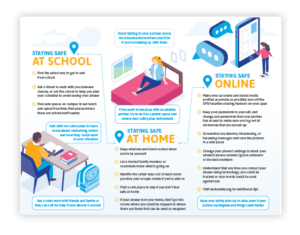Teen Safety Planning
Download Your Teen Safety Planning Guide

A safety plan is a personalized, practical plan that includes information and strategies to remain safe while in an abusive relationship, when planning to leave, or after you leave. Here are some helpful ways to stay safe at school, at home and online.
Remember Your Emotional Safety

Trust your Instincts

If it doesn‘t feel right to you, it probably isn‘t

Set Boundaries

You have a right to be safe and to set your own boundaries

It is Not Your Fault

No one deserves to be abused physically, sexually, emotionally, or verbally — it‘s not your fault, no matter what your partner says

Take Time for You

Do activities you enjoy and spend time with supportive family and friends
Helpful Items to Keep with You at All Times


A working cell phone and charger


Spare cash in case abuser gets into your phone-pay apps


Keys


Driver’s License and/or other important ID


Copy of restraining order


Important phone numbers of people/places you trust


Your safety plan

Staying Safe at School


Create a Safe Route

Find the safest way to get to and from school

Avoid Seeing Your Abuser

Ask a friend to walk with you between classes, or ask the school to help you plan your schedule

Safe Space

Find safe spaces on campus to eat lunch and spend free time; find places where there are school staff nearby
Staying Safe at Home


Stay Secure

Keep windows and doors locked when you’re by yourself

Communicate

Let a trusted family member or roommate know what is going on

Get Out

Identify the safest ways out of each room; practice your escape routes if you’re able to

Don’t Feel Safe at Home?

Find a safe place to stay with a friend or other family member

If Your Abuser is in Your Home

Don’t go into rooms where you could be trapped or where there are items that can be used as weapons
Staying Safe Online


Private Mode

Make your accounts and social media profiles as private as possible; turn off the GPS/location-sharing features on your apps

Log Out

Keep your passwords to yourself, and change any passwords that your partner has access to; make sure you log out of all devices that are synced up

Document

Screenshot any abusive, threatening, or harassing messages and save the pictures in a safe place

Block User & Caller

Change your phone’s settings to block your abuser’s phone number; ignore unknown or blocked numbers

Use Your Words Wisely

Understand that any time you contact your abuser using technology, you could be tracked or your words could be used against you

Visit

techsafety.org for additional tips
Additional Tips


Talk with Our Advocates

To learn more about restraining orders and how they could work in your situation

Use a code word

With friends and family so they can call for help if your abuser is around

Avoid Meeting Alone

Avoid talking to your partner alone; let someone know where you’ll be if you’re meeting up with them

Meet in a Public Space

If you want to break up with an abusive partner, try to do it in a public space and review your safety plan beforehand

Have Your Safety Plan Handy

Keep your safety plan up-to-date, even if your partner apologizes and things seem better







